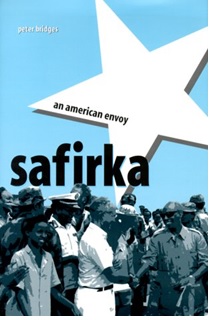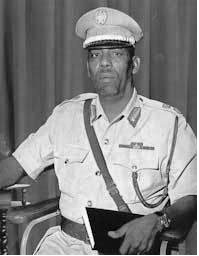Reviewed by : Abdirahman A. Issa
Book: Safiirka
Author: Peter Bridges
Publisher: Kent State University Press
Pages: 266
Language: English
Publication date: 2000
Peter Bridges is an American career diplomat who has served in American foreign service for three decades. He was posted in Panama, Russia, Czechoslovakia, and Italy before being appointed ambassador to Somalia in the mid-eighties. In his memoir Safirka: An American envoy, he mainly talks about his tenure in Somalia from 1984-1986. He portrays Somalia as a country with poor, sunny, and proud people and, more importantly, with a begging bowl with an insatiable, greedy and ruthless dictator at the helm. He was appointed to manage America’s largest Aid in sub-Saharan Africa, amounting to 120 millions of military and civilian Aid, which was a large amount of money at the time.

The ambassador’s time coincides with a renewal of American interest in the turbulent but strategic Horn of Africa. With the peak of the Cold War and the Ogaden War fiasco, the US government was determined to sway Somalia from the Soviet orbit. A deal was reached between the two governments that the US would have access to military and naval facilities in Somalia in return for military and economic Aid. As per the Reagan Administration National Security Decision Directive of 1982, “The Horn of Africa is important to the United States primarily because of its strategic location with respect to the Persian Gulf/Southwest Asia region.” However, Peter believed Somali’s strategic importance was overrated and not as important as Washington said. Even before he was appointed as Ambassador, Peter’s attitude towards Somalia was overly negative, and he may have harbored racism towards Somalis. After all, he was a Southerner and whites who hail from that part of the United States are known for their hostilities towards black people.
Peter provides a glimpse of the general atmosphere of repression and fear that permeated in Somalia at the time. He delineated what it was like to serve as Ambassador under a totalitarian regime deftly exploiting the cold war rivalry between the Western democracies and communist countries. The ambassador narrated his first encounter with the late dictator. When he finally met, Siad Barre warned him not to listen to traitors, and if he (the ambassador) wanted facts about the country, he should come to him directly any time. He even played a duplicitous game with him when he ordered his soldiers not to allow Somali invitees to a banquet thrown by the US Embassy for Somali students who graduated from American Universities. He later apologized to the ambassador and told him that it was his subordinates who acted without his permission. The deceit and trickery were his modus operandi with his dealing with both Somalis and foreigners for 21 years of his misrule.

A recurring theme throughout the book is the Aid West Poured to Somalia and how the military regime mismanaged and misappropriated it. He describes how the Somali officials from Siad Barre to the lowest ranking officials were demanding more Aid to be provided to Somalia. He portrayed them as hungry wolves who clamored for more alms to devour without a hint of shame or irony.
A British Ambassador to Somalia and Arabist recommended Peter to read “The First Footsteps in East Africa” by Richard Burton. In the book, Mr. Burton said that Arabs called Somalia Bilaad Wax Isii
(The land of give me something ).
Somali was receiving a large amount of humanitarian, development and military Aid during the ambassador’s stay in Somalia. But Peter did not see any meaningful impact on the ordinary citizens since the Somali Government’s officials were embezzling the aid. Most of the Aid was intended for the refugees from the Ogaden, whose number the regime inflated, but when he visited the camps, he was not convinced of the Somali government’s figure.
Amb Peter observed most development projects did crumble after a few years of completion due to a lack of maintenance by the Somali officials. If the projects were to succeed, he argued, they must be run by foreigners for many years. Basically, Somali officials were irresponsible, incompetent and had no regard for the future wellbeing of their country.
He tells how the Somali government was creating unnecessary fear that Ethiopia was invading Somalia in order to elicit more Military support from friendly foreign countries.
Amb Peter was astounded how “The Land of Give Me Something” even wanted to get Aid from the Catholics Church without allowing it to proselytize. The ambassador says the greed of Somali officials had known no limits. He said they would have done anything to squeeze a few dollars from anybody that is willing to spare some changes. One of their schemes to get more was come up by the country’s vice president General Samatar when he suggested establishing a diplomatic relationship with the Vatican through a former white house official.
The desperation for money even prompted Siad Barre to mend fences with Libya —the arch enemy of America —to get Aid from them and to stop their support to Somali Salvation Democratic Front (SSDF).” Somalia’s approaches to South Africa, Libya and the Soviet Union might reflect venality of Siad Barre and his foster brother (Abdirahman Jama Barre), “he notes
He describes how shamelessly Somalia organized an International Conference on Drought Emergency, despite the rain beginning to pour. The donors advised against organizing the conference and warned the Somali officials not to embarrass their country. Still, they went ahead, and to their utter disappointment, no additional pledge was made by the donors. A delegation from Italy who traveled to Beldweyne to assess the drought situation couldn’t land because constant rains had flooded the runway.
He recalls a time he was stunned and angered when he was informed the clothes 21 October marchers wearing (one day use) had taken a government factory to produce them for many months while Siad Barre had constantly been imploring him to supply uniforms for his army, telling him they “were half naked and he had no money to buy anything, and his friends didn’t want to help.”
Amb Peter recognizes that the IMF structural adjustment program had not solved Somalia’s fiscal and budgetary problems, and some of the provisions worsened the situation. He notes that it did not seem possible to them that Somalia would ever repay the loans but the ambassador said he was surprised that Somalia was still seeking more loans from lenders.
One of the issues he was greatly concerned about was the Population Question. He believed famines and wars were due to overpopulation and that something must be done about the population growth. He raised the issue without instruction from Washington with Siad Barre, who told him, to his surprise, that Somalia was underpopulated and needed more people to defend their country from Ethiopia. The ambassador here seems to be overstepping a little bit because he says that he wanted the population growth to be halted in Somalia and was on the opinion that the death of many people would restore the “balance of humans and their fragile environment”, but he laments “the civil war didn’t help restore the balance of nature but devastated the country further”. It is a callous and again sign of racism that he (ambassador Bridges) wanted more Somalis to die because somehow, he thought that the country was overpopulated. And more death of the Somali people was an acceptable and perhaps preferable remedy for eco balance. It is a shocking revealing admission of racism and utter lack of human sympathy on his part.
He had no instruction from Washington to raise Human Rights issues with the country’s leadership. Democracy and human rights were non-issues to Washington, and they were only concerned with the containment of Soviet expansion in third world countries. The west feared if they pushed for more political reform, the Third World countries would go to the Soviet Union as an alternative. The United States represented by ambassador Peter Bridges had no qualm about supporting a regime “at war with its own people”. Congress stopped the American support after the end of the cold war and the disintegration of the Soviets was in the offing. As a result of these dynamics, Somalia was no longer important to US interests.
The sad part of the book is when Sharif, a long-time driver for the embassy, hand overed his life savings to one of the embassy officers who he was expecting to take to outside the country, but he had locked it in the embassy locks, thus losing his lifetime-savings. The embassy only evacuated their citizens, turning down their Somali staff; and some of them, unfortunately, were killed in the embassy compound. The last US helicopter lifted from the embassy’s ground observing from above Somalia descending into civil war. The US was not blameless because they have been supporting a ruthless regime killing its own people, and haven’t lifted a finger to intervene; they didn’t even evacuate their Somali employees who desperately begged them for help.
Peter and other Ambassadors rightly predicted the dictator would not remain in power because of his advanced age and the collapse of government institutions around him, but they were not expecting the country would descend into chaos and bloodshed.
The book is a readable account enriched with sad anecdotes of Barre’s misrule and his mismanagement of western Aid by his regime. However, the American ambassador didn’t assign any blame to himself or his government and other western governments’ role in the sad story of Somalia. He took no responsibilities for their support of the regime when it was serving their interests and thus prolonging Barre’s reign of terror. Finally, The Ambassador’s account is vivid and detailed with some tangible facts. But he came across through pages as a righteous self-centered and prejudiced white man who had no regard and iota of sympathy for the people of Somalia.
Reviewed by Abdirahman A. Issa
———–
Mr Issa is a researcher of Somali History, culture, society and politics. His interests also include governance and development in fragile and post conflict contexts. He can be reached at [email protected]
We welcome the submission of all articles for possible publication on WardheerNews.com. WardheerNews will only consider articles sent exclusively. Please email your article today . Opinions expressed in this article are those of the author and do not necessarily reflect the views of WardheerNews.
WardheerNew’s tolerance platform is engaging with diversity of opinion, political ideology and self-expression. Tolerance is a necessary ingredient for creativity and civility.Tolerance fuels tenacity and audacity.
WardheerNews waxay tixgelin gaara siinaysaa maqaaladaha sida gaarka ah loogu soo diro ee aan lagu daabicin goobo kale. Maqaalkani wuxuu ka turjumayaa aragtida Qoraaga loomana fasiran karo tan WardheerNews.
Copyright © 2024 WardheerNews, All rights reserved


